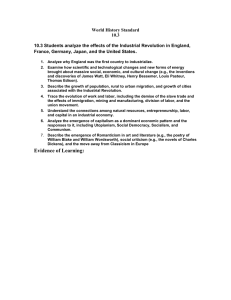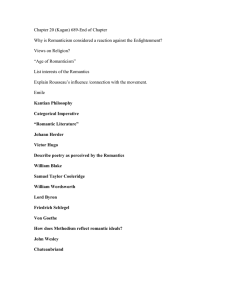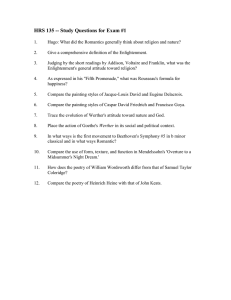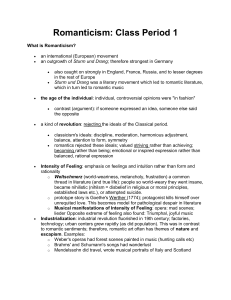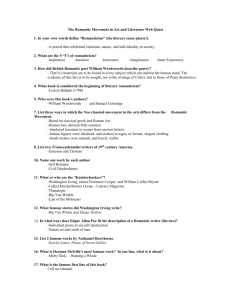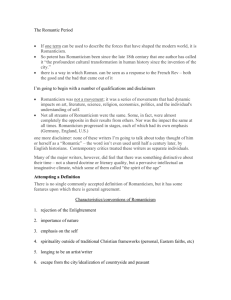Origins of Romanticism: Wordsworth & the Romantic Revolution
advertisement
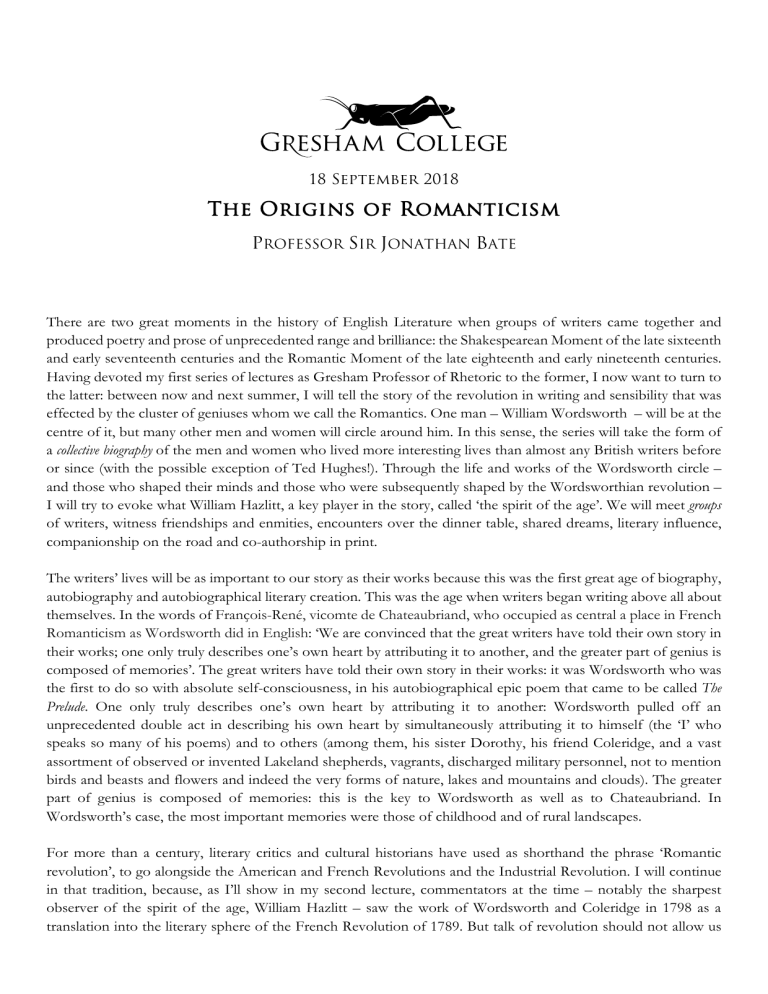
18 September 2018 The Origins of Romanticism PROFESSOR SIR JONATHAN BATE There are two great moments in the history of English Literature when groups of writers came together and produced poetry and prose of unprecedented range and brilliance: the Shakespearean Moment of the late sixteenth and early seventeenth centuries and the Romantic Moment of the late eighteenth and early nineteenth centuries. Having devoted my first series of lectures as Gresham Professor of Rhetoric to the former, I now want to turn to the latter: between now and next summer, I will tell the story of the revolution in writing and sensibility that was effected by the cluster of geniuses whom we call the Romantics. One man – William Wordsworth – will be at the centre of it, but many other men and women will circle around him. In this sense, the series will take the form of a collective biography of the men and women who lived more interesting lives than almost any British writers before or since (with the possible exception of Ted Hughes!). Through the life and works of the Wordsworth circle – and those who shaped their minds and those who were subsequently shaped by the Wordsworthian revolution – I will try to evoke what William Hazlitt, a key player in the story, called ‘the spirit of the age’. We will meet groups of writers, witness friendships and enmities, encounters over the dinner table, shared dreams, literary influence, companionship on the road and co-authorship in print. The writers’ lives will be as important to our story as their works because this was the first great age of biography, autobiography and autobiographical literary creation. This was the age when writers began writing above all about themselves. In the words of François-René, vicomte de Chateaubriand, who occupied as central a place in French Romanticism as Wordsworth did in English: ‘We are convinced that the great writers have told their own story in their works; one only truly describes one’s own heart by attributing it to another, and the greater part of genius is composed of memories’. The great writers have told their own story in their works: it was Wordsworth who was the first to do so with absolute self-consciousness, in his autobiographical epic poem that came to be called The Prelude. One only truly describes one’s own heart by attributing it to another: Wordsworth pulled off an unprecedented double act in describing his own heart by simultaneously attributing it to himself (the ‘I’ who speaks so many of his poems) and to others (among them, his sister Dorothy, his friend Coleridge, and a vast assortment of observed or invented Lakeland shepherds, vagrants, discharged military personnel, not to mention birds and beasts and flowers and indeed the very forms of nature, lakes and mountains and clouds). The greater part of genius is composed of memories: this is the key to Wordsworth as well as to Chateaubriand. In Wordsworth’s case, the most important memories were those of childhood and of rural landscapes. For more than a century, literary critics and cultural historians have used as shorthand the phrase ‘Romantic revolution’, to go alongside the American and French Revolutions and the Industrial Revolution. I will continue in that tradition, because, as I’ll show in my second lecture, commentators at the time – notably the sharpest observer of the spirit of the age, William Hazlitt – saw the work of Wordsworth and Coleridge in 1798 as a translation into the literary sphere of the French Revolution of 1789. But talk of revolution should not allow us to fall into the trap of setting up a complete opposition between Classic and Romantic, or the Age of Reason and the Age of Feeling, or the Johnsonian Era and the Wordsworthian Era. It is true that the death in 1784 of Dr Samuel Johnson, the towering literary figure of the eighteenth century, marked the end of an era, and coincided with a burst of new publications of strong poetic feeling or ‘sensibility’ – works such as the Poetical Sketches of William Blake (1783), the Elegiac Sonnets of Charlotte Smith (1784) and The Task of William Cowper (1785). But it is equally true that the greatest of all biographies, Boswell’s Life of Johnson, belongs to the ‘revolutionary’ decade that followed: it was published in 1791. An underlying argument of this lecture series will be that we are wrong to associate Romanticism only with the solitary genius alone in a garret, that we have been seduced by such images as the pre-Raphaelite portrait of The Death of Chatterton (very garret, notice also the scattered papers, the open collar, the swoon of death) and the portraits by Joseph Severn of John Keats in solitary rapt contemplation. On the left, placing him in his room in Hampstead, his presiders are a portrait of Shakespeare on the wall and an unseen nightingale singing through the open garden door; on the right, he is alone with his thoughts, though once again with a book to inspire him, as in his poem ‘On First Looking into Chapman’s Homer’: Much have I travelled in the realms of gold, And many goodly states and kingdoms seen; Round many western islands have I been Which bards in fealty to Apollo hold. Oft of one wide expanse had I been told That deep-browed Homer ruled as his demesne; Yet did I never breathe its pure serene Till I heard Chapman speak out loud and bold: Then felt I like some watcher of the skies When a new planet swims into his ken; Or like stout Cortez when with eagle eyes He stared at the Pacific—and all his men Looked at each other with a wild surmise— Silent, upon a peak in Darien. There is, however, a double sense in which Keats is not alone: for one thing, we only have these portraits because of his friendship with Joseph Severn, who was there at his death and who oversaw the erection of his gravestone according to the poet’s own wishes (‘Here lies one whose name was writ in water’). Secondly, Keats was acutely indebted to the great poets of the past – that, after all, is what the sonnet on reading the translation of Homer is all about, just as his sonnet on sitting down to read King Lear once again is about his bond with Shakespeare. Yes, the Romantics did write in reaction against the closed couplets and regular rhythms of Alexander Pope and, still more, the slack poeticisms of later eighteenth-century writing, in which a fish is a member of ‘the finny tribe’ and a sheep one of ‘the bleating kind’. But their method of reacting was more often than not to return to older poetic traditions: to revive the sonnet form, to imitate border ballads, above all to write supple blank verse in the manner of Milton and Shakespeare. In this opening lecture I want to offer a lightning sketch of ‘the spirit of the age’, then a brisk tour d’horizon through the characters and ideas that we will be meeting, and then a brief attempt at an answer to the question: what were the principal origins of Romanticism. First, then, what do we mean by Romanticism and why does it matter? What was the intellectual historian Isaiah Berlin getting at when he wrote that ‘The importance of romanticism is that it is the largest recent movement to transform the lives and thought of the Western world. It seems to me to be the greatest single shift in the 2 consciousness of the West that has occurred, and that all the other shifts which have occurred in the course of the nineteenth and twentieth centuries appear to me in comparison less important, and at any rate deeply influenced by it’? The key word here is consciousness: Romanticism was above all a movement of ideas. The idea of revolution and the idea of nationalism. The preposterous suggestion that women, slaves and even animals might have rights. Reverence for nature. Vegetarianism and environmental consciousness. The radical theory of anarchism and the conservative theory of the organic state. The cult of personality and the idea of sincerity. The reinvention of poetry as the expression of the self. The belief that nothing matters more to us as human beings than our sensations, our feelings, that individualism and an individual’s ideals (whatever they may be) define our freedom and our modernity. The practice of free love and the establishment of idealistic communes. The vogue for naturalness in dress: no powdered wig, a figure-hugging dress resembling a chemise. Short hair for women and long hair for men. The conception of ‘the aesthetic’, which is to say a philosophical theory of beauty. The modern meanings of the words ‘imagination’, ‘creativity’, ‘genius’, ‘literature’. The freedom fighter on the streets and the hiker in the mountains. The seaside holiday and the cult of celebrity. A public appetite for sensation. The vampire story and the science fiction novel. The worship of Shakespeare. The alarming notion that it might be glamorous to take drugs or commit suicide—or at the very least to live hard and die young. Weltschmerz and ennui. The rebel and the outsider; the egotist and the altruist. These are all ideas that emerged or grew in the Romantic age. That is why the Romantic Revolution was the making of the modern mind. Let me elaborate by giving just one or two examples of some of these themes. The idea of revolution. The American Declaration of Independence was underpinned by Enlightenment ideas of rights, of liberty, life and the pursuit of happiness, but for a rebellious poet in Britain such as William Blake it was a new dawn, a harbinger of the New Jerusalem that would, he believed, one day be built in England’s green and pleasant land: ‘The morning comes, the night decays, the watchmen leave their stations; / The grave is burst, the spices shed, the linen wrapped up’. Next time I’ll talk about how Wordsworth welcomed the French Revolution as a dawn, in which it was bliss to be alive and to be young was very heaven. But he was also inspired by the Haitian Revolution, led by the slave Toussaint L’Ouverture, in whose memory he wrote a glorious sonnet: Live, and take comfort. Thou hast left behind Powers that will work for thee; air, earth, and skies; There’s not a breathing of the common wind That will forget thee; thou hast great allies; Thy friends are exultations, agonies, And love, and man’s unconquerable mind. The spirit of Romanticism is nowhere better summarized than in this train of thought, with its invocation first of air, earth, sky and inspiring wind, then of exultations, agonies, love, and man’s unconquerable mind. Reactions in favour of – or against – the spirit of revolution were everywhere in the literature of the 1790s. The most fashionable literary genre of the 1790s was the Gothic novel, of which Mrs Ann Radcliffe, author of the bestselling Mysteries of Udolpho, was queen (as we know from Jane Austen’s waspish parody in Northanger Abbey). Why? What was it about the age that led to a taste for gloomy castles, medievalism and villainous monks? The Marquis de Sade had an answer. He thought that Matthew Lewis’s Gothic shocker The Monk (which features a sex-maniac rapist monk, incest, demonic influence, the Wandering Jew, a castle of sadistic nuns, a rampaging mob, and the Spanish Inquisition) was the greatest novel of the age. He suggested that the bloody terror of the French Revolution had rendered everyday reality so horrific that only the demonic and the supernatural were sufficient to create a greater horror in the realm of literature. Sade himself regarded libertinism as of a piece with the spirit 3 of revolution. He wrote his most notorious work, 120 Days of Sodom, whilst imprisoned in the Bastille and for a time he represented the Jacobin cause at its most radical – before he was dispatched to prison by Napoleon (and then transferred to a lunatic asylum), for having written Justine or The Misfortunes of Virtue and its sequel Juliet or the Prosperities of Vice, in which disquisitions on theology, morality, aesthetics and politics jostle with extreme pornographic scenes from the happy and successful life of an amoral nymphomaniac murderess. In England, the ‘anti-Jacobin’ press attacked The Monk as a sign of the decadent times, deeming it blasphemous pornographic diablerie. ‘Monk’ Lewis, dramatist and novelist, traveller and Member of Parliament, was also author of such delicious Gothic extravaganzas as his smash-hit play for Drury Lane, The Castle Spectre, his spectacular equestrian opera for Covent Garden, Timour the Tartar, and his disastrous anthology of semi-plagiarized Gothic ballads, Tales of Wonder (which was variously parodied as Tales of Plunder and Tales of Terror). Second-rate author that he was, his works shaped the sensibility of the age (as witnessed by James Gillray’s caricature ‘Tales of Wonder’) and were a profound influence on the two most widely-read authors in Europe: Sir Walter Scott and Lord Byron. The idea of nationalism. It all began in Germany – and where it ended in Germany is a very dark place indeed. In brief: during the eighteenth century, Germany was not a nation but a collection of principalities, of which Prussia was the most powerful. The language of the aristocracy, the courts, of politics, diplomacy and public life was French. And the culture was accordingly dominated by French models, French neo-classical values. The early phase of Romanticism known as the Stürm und Drang – storm and stress – was devoted to the overthrow of those values, to the espousal of a native German culture in opposition to all things French. The key figure in this movement was Johann Gottfried Herder. He despised Prussian autocracy and its code of military nationalism, arguing instead that the true spirit of Germany was to be found in the traditions of the Volk – in ballads and songs, the traditions of the peasantry and the land. The models to follow were not the polished elite French ones such as the writings of Voltaire and the tragedies of Racine, but rather the raw, energetic, native plays and poems of Britain – Shakespeare’s history plays, in which he gave the people the history of his own nation, and, on the Celtic fringe, the poems of Ossian, to which we will come at the end of this lecture. Herder’s battle cry was taken up by Goethe and Schiller, the founders of German drama and Weimar culture, as they wrote in German, about German stories, in the style of Shakespeare. From Herder, then, there is a direct line through to the apex of German Romanticism in the music-dramas of Richard Wagner. And from there to the most catastrophic form of German Nationalism: ‘At the age of twelve, I saw ... the first opera of my life, Lohengrin. In one instant I was addicted. My youthful enthusiasm for the Bayreuth Master knew no bounds’ (Mein Kampf). Romanticism: the simultaneous spirit of atavism and progress, of looking back and looking forward. The preposterous suggestion that women, slaves and even animals might have rights: Thomas Paine welcomes the French Revolution in The Rights of Man; Mary Wollstonecraft responds with her Vindication of the Rights of Woman; the cause of slavery is taken up and abolition owes a huge debt to Wordsworth’s friend Thomas Clarkson. ON THE FINAL PASSING OF THE BILL FOR THE ABOLITION OF THE SLAVE TRADE - MARCH 1807 CLARKSON! it was an obstinate hill to climb: How toilsome--nay, how dire--it was, by thee Is known; by none, perhaps, so feelingly: But thou, who, starting in thy fervent prime, Didst first lead forth that enterprise sublime, Hast heard the constant Voice its charge repeat, Which, out of thy young heart's oracular seat, 4 First roused thee … The blood-stained Writing is for ever torn; And thou henceforth wilt have a good man's calm, A great man's happiness; thy zeal shall find Repose at length, firm friend of human kind! Think now of the idea of rights as a circle of extending circumference. The French Revolution proclaims the rights of man. Woolstonecraft advocates the rights of woman, Clarkson the rights of slaves. Then in 1791, John Oswald, a Scottish Jacobin in revolutionary Paris, publishes The Cry of Nature or An Appeal to Mercy and Justice on Behalf of the Persecuted Animals, arguing the case for the rights of nature and becoming one of the first to espouse vegetarianism. That cause is taken up by others, such as a doctor called William Lambe who followed a diet consisting entirely of vegetable matter accompanied by distilled water. An old Harrovian anti-slavery activist called John Frank Newton prescribed this diet to his family and in 1811 published a book called Return to Nature, or a Defence of the Vegetable Regimen. He soon became friends with the poet Percy Bysshe Shelley, who was a passionate vegetarian. Newton was introduced to Shelley via the poet’s father-in-law, Mary Wollstonecraft’s husband William Godwin. Another apologist for the French Revolution, he was the inventor of the radical theory of philosophical anarchism – the idea that man is innately good, but is corrupted by the institutions of society such as government, education and marriage. Godwin was the mighty opposite of Edmund Burke, who in attacking the French Revolution invented the conservative theory of the organic state, the idea of the evolving English constitution as a metaphoric oak tree and of society as “a partnership not only between those who are living, but between those who are living, those who are dead, and those who are to be born”. An intellectual revolution cannot be achieved without its means of dissemination, and in this regard one of the forgotten architects of Romanticism was Joseph Johnson, one of Godwin’s publishers. He did more than anyone else to create Romanticism in print. English radical thought and Britain’s favourable responses to the French Revolution were above all shaped by an extraordinary circle of writers and intellectuals whose works were all brought into print by the religious Dissenter Johnson – they regularly gathered at his house for dinner parties at three o’clock in the afternoon. Among them were: Joseph Priestley, Anna Barbauld, William Godwin, Mary Wollstonecraft (her writing of the Vindication of the Rights of Woman was Johnson’s idea), the painter Henry Fuseli – and William Blake. Johnson’s publishing career reveals the vital importance of religious Dissent and of the American Revolution in the new ferment of ideas. Ultimately, though, Romanticism was more a revolution of the self than of the state. That is why I have spoken of the cult of personality and the idea of sincerity; the reinvention of poetry as the expression of the self; the belief that nothing matters more to us as human beings than our sensations, our feelings, that individualism and an individual’s ideals (whatever they may be) define our freedom and our modernity. Listen to Samuel Taylor Coleridge writing about himself, in a letter to the aforementioned William Godwin [Jan 22nd 1802]: Partly from ill-health, & partly from an unhealthy & reverie-like vividness of Thoughts, & (pardon the pedantry of the phrase) a diminished Impressibility from Things, my ideas, wishes, & feelings are to a diseased degree disconnected from motion & action. In plain & natural English, I am a dreaming & therefore an indolent man——. I am a Starling self-incaged, & always in the Moult, & my whole Note is, Tomorrow, & tomorrow, & tomorrow. The same causes, that have robbed me to so great a degree of the self-impelling self-directing Principle, have deprived me too of the due powers of Resistances to Impulses from without. If I might so say, I am, as an acting man, a creature of mere Impact. 'I will' & 'I will not' are phrases, both of them equally, of rare occurrence in my dictionary.—This is the Truth—I regret it, & in 5 the consciousness of this Truth I lose a larger portion of Self-estimation than those, who know me imperfectly, would easily believe—/ I evade the sentence of my own Conscience by no quibbles of selfadulation; I ask for Mercy indeed on the score of my ill-health; but I confess, that this very ill-health is as much an effect as a cause of this want of steadiness & self-command; and it is for mercy that I ask, not for justice. One can see why Hamlet was the Romantics’ favourite Shakespearean character. The essence of Romanticism was first crystallized by the German philosopher Friedrich Schlegel in one of a series of aphoristic fragments published in the late 1790s: Romantic poetry is a progressive, universal poetry. Its aim isn’t merely to reunite all the separate species of poetry and put poetry in touch with philosophy and rhetoric. It tries to and should mix and fuse poetry and prose, inspiration and criticism, the poetry of art and the poetry of nature; and make poetry lively and sociable, and life and society poetical; poeticize wit and fill and saturate the forms of art with every kind of good, solid matter for instruction, and animate them with the pulsations of humour. It embraces everything that is purely poetic, from the greatest systems of art, containing within themselves still further systems, to the sigh, the kiss that the poetizing child breathes forth in artless song. … It alone can become, like the epic, a mirror of the whole circumambient world, an image of the age. … Other kinds of poetry are finished and are now capable of being fully analyzed. The romantic kind of poetry is still in the state of becoming; that, in fact, is its real essence: that it should forever be becoming and never be perfected. It can be exhausted by no theory and only a divinatory criticism would dare try to characterize its ideal. It alone is infinite, just as it alone is free; and it recognizes as its first commandment that the will of the poet can tolerate no law above itself. The romantic kind of poetry is the only one that is more than a kind, that is, as it were, poetry itself: for in a certain sense all poetry is or should be romantic. 1 Friedrich Schlegel’s brother, August Wilhelm von Schlegel, was an equally important figure in the history of German Romanticism – and a more influential one in England, because his Lectures on Dramatic Art and Literature, delivered in Vienna in 1808, were published in English, plagiarized by Coleridge and exercised an influence on the Shakespearean lectures of Hazlitt. This Schlegel brother described Goethe’s novel The Sorrows of Young Werther as a declaration of the rights of feeling, and that is as good a definition of Romanticism as one is likely to find – and certainly a more concise one than that of his brother, which we have just been looking at. The mature Goethe, who may reasonably be described as the creator of classical German culture, renounced Romanticism when it was in full flow: he said that it embodied everything that was sick. But his own thinly disguised autobiographical novel of love sickness was one of the absolute foundational works of the movement. Written in the popular epistolary style of letters to a friend in which the narrator pours out his heart, the novel tells of how young Werther moves into a rural community and is enchanted by the simple ways of the peasantry – this ‘return to nature’ motif is going to be at the centre of Romanticism. He falls in love with a girl called Charlotte, but she is engaged to another. He tries to sustain the relationship as a mere friendship, but cannot, so he blows out his brains. The quintessence, then, of Romanticism in the sense of the belief that there is nothing more glorious, intense and painful than youthful unrequited love – the perfect material for poetry. Late in his own life, Goethe said that everybody has a time in their life when they feel as though Werther had been written exclusively for them. Napoleon Bonaparte certainly thought so: he wrote a monologue inspired by Werther and 1 Friedrich Schlegel, Athenäums-fragmente (1798), # 116, translated by Peter Firchow. 6 carried a copy of the book in his pocket on his military campaigns. Across Europe, young men dressed in Werther’s clothes. Images from the novel were marketed as engravings, as silhouettes, on Meissen pottery. You could even buy a perfume called eau de Werther. Stories began to circulate of young men with broken hearts, all across Europe, committing suicide in imitation of their hero. It is in fact hard to track down any genuine documented cases, but the panic stirred by the media was such that in some cities, such as Copenhagen and Leipzig, the novel was banned. Psychologists still speak of ‘the Werther effect’, the idea that the will to suicide can be a kind of contagion among groups of alienated or unhappy young people. In this regard, Romanticism has a lot to answer for: of course we want our young people to rebel, to find themselves, to express themselves, to be disgusted with bourgeois society, to feel despair and world-weariness, Weltschmerz and ennui, but we also want them to grow out of all those things. For Romanticism, however, there is nothing more glamorous than to live fast and die young. In this sense, the self-destruct button inherent in the rock star – James Dean, Kurt Cobain, Amy Winehouse – is an inheritance of Romanticism. Keats, Shelley and Byron all made the smart career move of dying young (though, in their cases, none of them deliberately): poor old Wordsworth lived to the age of eighty and became a bore and a reactionary, with the result that he has never had the glamour associated with those who died young – or indeed with other Romantics who lived longer, but descended into drugs (Coleridge, De Quincey the opium eater, Baudelaire in France) or madness (John Clare, who spent the last twenty-six years of his life in lunatic asylums). The cult of youth and early death, together with a reaction against the polished classicism of eighteenth century poetry and a desire to return to the simple energies of medieval ballads and the like, accounts for the Romantic fascination with Thomas Chatterton. Born in Bristol in 1752 and raised in humble circumstances, he was an astonishingly precocious genius – another Romantic archetype – who began publishing accomplished poetry at the age of eleven. He passed off his work as that of an invented fifteenth-century bard called Thomas Rowley. Failing to find a patron in the provinces, he moved to London, scribbling away in his garret in dire poverty, first in Shoreditch, then in Holborn. There is a story that one day he was walking with a friend in St Pancras’ Churchyard, so absorbed in inward communion with is Muse that he fell into a newly dug grave. His companion helped him out and joked that he was glad to assist in the resurrection of genius, to which Chatterton replied, ‘My dear friend, I have been at war with the grave for some time now’. Three days later, he took home a portion of arsenic, tore up his literary remains and drank the poison. Though it has recently been suggested that the arsenic was bought as a cure for syphilis and that the overdose was accidental, the Romantics had no reason to doubt the verdict of the inquest that the cause of death was suicide in a fit of madness. After all, even the supremely classical poet John Dryden had said that great wits are to madness near allied. Robert Southey, the now almost forgotten Lake Poet who had, with Coleridge, once planned to form a utopian ‘Pantisocratic’ community of free love on the banks of the Susquehanna River, lamented that Chatterton’s sad story is well known; his life the wonder, his death the disgrace of his country. That a boy of seventeen years should have afforded a subject for dispute to the first criticks and scholars of his time is scarcely to be credited: who then shall believe that this prodigy of nature should be left a prey to indigence and famine! The idea that Keats was killed by the sheer malice of his negative reviews has its origins in this image of the neglected Chatterton. All the Romantics revered his memory: Coleridge wrote a ‘monody’ for him, Keats dedicated his longest poem, Endymion, to his memory, in France Alfred de Vigny dramatized his life and death in a play, Henry Wallis enshrined him in pre-Raphaelite art, and Wordsworth, in his poem ‘Resolution and Independence’, placed him beside another tortured, prematurely dead, ballad-writing poetic genius, Robert Burns: 7 I thought of Chatterton, the marvellous Boy, The sleepless Soul that perished in his pride; Of Him who walked in glory and in joy Following his plough, along the mountain-side: By our own spirits are we deified: We Poets in our youth begin in gladness; But thereof come in the end despondency and madness. The Romantics were, in a sense, retrospectively reinventing Chatterton as a Werther figure. The Sorrows of Young Werther is one of the books read by the Creature in the greatest of all Gothic novels, Mary Shelley’s Frankenstein. Mary Shelley was reading it herself, when in Geneva with her husband and Lord Byron in the period when the novel was written. She was also reading Holbach’s atheistic and materialistic System of Nature – another vital factor in the Romantic sensibility was the need to find forms of alternative religion as Enlightenment rationalism put paid to the certainties of traditional theological belief. In Wordsworth and others, the sublimity of nature itself took on a divine role. Although he later denied the accusation, and turned to the orthodoxies of the Anglican church, many of his contemporaries regarded him as a pantheist. Pantheism, the idea that God is to be found immanent in nature, not transcendent above, certainly seems to be the mood of his famous lines written in the Wye Valley, a few miles above Tintern Abbey: And I have felt A presence that disturbs me with the joy Of elevated thoughts; a sense sublime Of something far more deeply interfused, Whose dwelling is the light of setting suns, And the round ocean, and the living air, And the blue sky, and in the mind of man: A motion and a spirit, that impels All thinking things, all objects of all thought, And rolls through all things. Therefore am I still A lover of the meadows and the woods, And mountains; and of all that we behold From this green earth; of all the mighty world Of eye, and ear,— both what they half create, And what perceive; well pleased to recognize In nature and the language of the sense The anchor of my purest thoughts, the nurse, The guide, the guardian of my heart, and soul Of all my moral being. Mary Shelley was also reading Jean-Jacques Rousseau when she was in his native Geneva, at the time of Frankenstein, and Rousseau is indeed a key not only to that novel but to the entire Romantic movement. Back in 1754, Rousseau had entered an essay competition set by the Academy of Dijon, in which the question was ‘what was the origin of inequality among men?’ Rousseau’s answer was that inequality came with property and with the development of civil society in which differences of rank became all too apparent. In contrast to the inequality of the present, he posited a state of nature in which ‘natural man’ was unconstrained by social forces. Though he did not use the phrase, this is where the idea of the ‘noble savage’ came from – Mary Shelley actually makes her 8 Creature into just such a man, before he is corrupted by society and turns destructively against his maker. Rousseau’s point was not so much to argue that man ever really did live in a state of nature, but rather that the idea of the state of nature and man’s inherent goodness and perfectibility was a heuristic tool to show what was wrong with the inequalities of the present. From there it was a short step to the famous opening sentence of The Social Contract, truly one of the foundational texts of the French Revolution, published just a few years after the discourse on inequality: ‘Man is born free, and everywhere he is in chains’. If man in the state of nature was one example of humankind uncorrupted by the divisive inequality of social institutions, the other was of course the child. The Romantic child will be the theme of my third lecture, and there I’ll talk about Rousseau’s book on childhood and education, Émile, which in its model of natural child-rearing perhaps exerted more influence on the Romantic movement than any other single text. Since I’ll be returning to it, I shan’t talk about it today. I’ll end instead by suggesting that if you want a trio of books in which you’ll find the origins of Romanticism, they should be Werther, Émile and the poem that Werther reads to Charlotte in their last and most romantic moment. The character of Werther introduces it in a letter written as he is being seized by the madness of his passion: Ossian has superseded Homer in my heart. To what a world does the illustrious bard carry me! To wander over pathless wilds, surrounded by impetuous whirlwinds, where, by the feeble light of the moon, we see the spirits of our ancestors; to hear from the mountain-tops, mid the roar of torrents, their plaintive sounds issuing from deep caverns, and the sorrowful lamentations of a maiden who sighs and expires on the mossy tomb of the warrior by whom she was adored. I meet this bard with silver hair; he wanders in the valley; he seeks the footsteps of his fathers, and, alas! he finds only their tombs. Then, contemplating the pale moon, as she sinks beneath the waves of the rolling sea, the memory of bygone days strikes the mind of the hero, days when approaching danger invigorated the brave, and the moon shone upon his bark laden with spoils, and returning in triumph. When I read in his countenance deep sorrow, when I see his dying glory sink exhausted into the grave, as he inhales new and heart-thrilling delight from his approaching union with his beloved. In his final meeting with Charlotte, after which he walks into a dark and stormy night to prepare himself for suicide, Werther reads her a long passage from this work in his own translation – that is to say, Goethe’s translation. With eyes full of tears, he begins to read: Star of descending night! fair is thy light in the west! thou liftest thy unshorn head from thy cloud; thy steps are stately on thy hill. What dost thou behold in the plain? The stormy winds are laid. The murmur of the torrent comes from afar. Roaring waves climb the distant rock. The flies of evening are on their feeble wings: the hum of their course is on the field. What dost thou behold, fair light? But thou dost smile and depart. The waves come with joy around thee: they bathe thy lovely hair. On and on he reads, until The whole force of these words fell upon the unfortunate Werther. Full of despair, he threw himself at Charlotte’s feet, seized her hands, and pressed them to his eyes and to his forehead. An apprehension of his fatal project now struck her for the first time. Her senses were bewildered: she held his hands, pressed them to her bosom; and, leaning toward him with emotions of the tenderest pity, her warm cheek touched his. They lost sight of everything. The world disappeared from their eyes. He clasped her in his arms, strained her to his bosom, and covered her trembling lips with passionate kisses. ‘Werther!’ she cried with a faint voice, turning herself away; ‘Werther!’ and, with a feeble hand, she pushed him from her. At length, 9 with the firm voice of virtue, she exclaimed, ‘Werther!’ He resisted not, but, tearing himself from her arms, fell on his knees before her. Charlotte rose, and, with disordered grief, in mingled tones of love and resentment, she exclaimed, ‘It is the last time, Werther! You shall never see me any more!’ Then, casting one last, tender look upon her unfortunate lover, she rushed into the adjoining room, and locked the door. Werther held out his arms, but did not dare to detain her. He continued on the ground, with his head resting on the sofa, for half an hour, till he heard a noise which brought him to his senses. The servant entered. He then walked up and down the room; and, when he was again left alone, he went to Charlotte's door, and, in a low voice, said, ‘Charlotte, Charlotte! but one word more, one last adieu!’ She returned no answer. He stopped, and listened and entreated; but all was silent. At length he tore himself from the place, crying, ‘Adieu, Charlotte, adieu for ever!’ The work in question was the epic poetry of Ossian, legendary Gaelic bard, whose works were discovered and translated – or were they forged, invented from pure imagination? – by James Macpherson in the early 1760s. The cult of Ossian, and the debate over the material’s authenticity, would be a subject for a whole lecture in itself. Modern scholarship has suggested that Macpherson did find many fragments of ancient Gaelic poetry – ballads and the like – and that he got help with his translation, but that the organization of his epic tales and huge swathes of the texts were indeed of his own making. Wordsworth, in his poem on Glen Almond, sensibly took the view that it didn’t matter whether or not Ossian was authentic: Does then the Bard sleep here indeed? Or is it but a groundless creed? What matters it?—I blame them not Whose fancy in this lonely spot Was moved; and in such way expressed Their notion of its perfect rest. A convent, even a hermit’s cell, Would break the silence of this Dell: It is not quiet, it is not ease; But something deeper far than these: The separation that is here Is of the grave; and of austere Yet happy feelings of the dead; And therefore was it rightly said That Ossian, last of all his race! Lies buried in this lonely place. The cult of Ossian had as great an effect on tourism as on literature – Fingal’s Cave in the Hebrides became the destination of choice for Romantic travellers. The Ossian poems embodied the spirit of primitivism; they gave the north an equivalent foundational epic to Homer in the south; they answered to a yearning for the heroic in an increasingly domestic age (the narrative is very Game of Thrones). They offered in Ossian himself a figure who was the embodiment of the impassioned Bard amidst the mighty forms of nature. They paved the way for both the idiosyncratic myth-making of William Blake and the sublime poetry of solitude voiced by William Wordsworth’s Wanderer: A Herdsman on the lonely mountain tops, Such intercourse was his, and in this sort Was his existence oftentimes possessed. 10 … in the mountains did he feel his faith. All things … there Breathed immortality, revolving life, And greatness still revolving; infinite: There littleness was not; the least of things Seemed infinite; and there his spirit shaped Her prospects, nor did he believe,--he saw. What wonder if his being thus became Sublime and comprehensive! © Professor Sir Jonathan Bate, 2018 11

